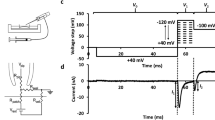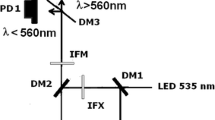Summary
A new, nonenzymatically treated preparation of amphibian sarcolemmal blebs has been used to study the regulation of skeletal muscle ATP-sensitive K+ [K(ATP)] channels.
When a frog skeletal muscle fiber is split in half in a Ca2+-free relaxing solution, large hemispherical membrane blebs appear spontaneously within minutes without need for Ca2+-induced contraction or enzymatic treatment. These blebs readily formed gigaseals with patch pipettes, and excised inside-out patches were found to contain a variety of K+ channels. Most prominent were K(ATP) channels similar to those found in the surface membrane of other muscle and nonmuscle cells. These channels were highly selective for K+, had a conductance of ≈ 53 pS in 140mmK+, and were blocked by internal ATP. The presence of these channels in most patches implies that split-fiber blebs are made up, at least in large part, of sarcolemmal membrane.
In this preparation, K(ATP) channels could be rapidly and reversibly blocked by glibenclamide (0.1–10 μm) in a dose-dependent manner. These channels were sensitive to ATP in the micromolar range in the absence of Mg. This sensitivity was noticeably reduced in the presence of millimolar Mg, most likely because of the ability of Mg2+ ions to bind ATP. Our data therefore suggest that free ATP is a much more potent inhibitor of these channels than MgATP. Channel sensitivity to ATP was significantly reduced by ADP in a manner consistent with a competition between ADP, a weak inhibitor, and ATP, a strong inhibitor, for the same inhibitory binding sites.
These observations suggest that the mechanisms of nucleotide regulation of skeletal muscle and pancreatic K(ATP) channels are more analogous than previously thought.
Similar content being viewed by others
References
Arena, J.P., Kass, R.S. 1989. Activation of ATP-sensitive K channels in heart cells by pinacidil: Dependence on ATP.Am. J. Physiol. 257:H2092-H2096
Ashcroft, F.M., Kakei, M. 1989. ATP-sensitive K− channels in pancreatic B-cells: Modulation by ATP and Mg2+ ions.J. Physiol. 416:349–367
Ashcroft, S.J.H., Ashcroft, F.M. 1990. Properties and functions of ATP-sensitive K-channels.Cell. Signal. 2:197–214
Belles, B., Hescheler, J., Trube, G. 1987. Changes of membrane currents in cardiac cells induced by long whole-cell recordings and tolbutamide.Pfluegers Arch. 409:582–588
Burton, F., Dörstelmann, U., Hutter, O.F. 1988. Single-channel activity in sarcolemmal vesicles from human and other mammalian muscles.Muscle Nerve 11:1029–1038
Davies, N.W. 1990. Modulation of ATP-sensitive K+ channels in skeletal muscle by intracellular protons.Nature 343:375–377
Dunne, M.J., Illot, M.C., Petersen, O.H. 1987. Interaction of diazoxyde, tolbutamide and ATP4− on nucleotide-dependent K+ channels in an insulin-secreting cell line.J. Membrane Biol. 99:215–224
Dunne, M.J., Petersen, O.H. 1986. Intracellular ADP activates K+ channels that are inhibited by ATP in an insulin-secreting cell line.FEBS Lett. 208:59–62
Dunne, M.J., West-Jordan, J.A., Abraham, R.J., Edwards, R.H.T., Petersen, O.H. 1988. The gating of nucleotide-sensitive K+ channels in insulin-secreting cells can be modulated by changes in the ratio ATP4−/ADP3− and by nonhydrolyzable derivatives of both ATP and ADP.J. Membrane Biol. 104:165–172
Fabiato, A. 1988. Computer programs for calculating total from specified or free from specified total ionic concentrations in aqueous solutions containing multiple metals and ligands.In: Methods in Enzymology. Vol. 157. pp. 378–417. S. Fleischer and B. Fleischer, editors. Academic, San Diego
Fan, Z., Nakayama, K., Hiraoka, M. 1990. Pinacidil activates the ATP-sensitive K+ channel in inside-out and cell-attached patch membranes of guinea-pig ventricular myocytes.Pfluegers Arch. 415:387–394
Findlay, I. 1987a. ATP-sensitive K+ channels in rat ventricular myocytes are blocked and inactivated by internal divalent cations.Pfluegers Arch. 410:313–320
Findlay, I. 1987b. The effects of magnesium upon adenosine triphosphate-sensitive potassium channels in a rat insulinsecreting cell line.J. Physiol. 391:611–629
Findlay, I. 1988a. ATP4− and ATP·Mg inhibit the ATP-sensitive K+ channel of rat ventricular myocytes.Pfluegers Arch. 412:37–41
Findlay, I. 1988b. Effects of ADP upon the ATP-sensitive K+ channel in rat ventricular myocytes.J. Membrane Biol. 101:83–92
Findlay, I., Dunne, M.J. 1986. ATP maintains ATP-inhibited K+ channels in an operational state.Pfluegers Arch. 407:238–240
Fosset, M., de Weille, J., Green, R.D., Schmid-Antomarchi, H., Lazdunski, M. 1988. Antidiabetic sulfonylureas control action potential properties in heart cells via high-affinity receptors that are linked to ATP-dependent K+ channels.J. Biol. Chem. 263:7933–7936
Gillis, K.D., Gee, W.M., Hammoud, A., McDaniel, M.L., Falke, L.C., Misler, S. 1989. Effects of sulfonamides on a metaboliteregulated ATP-sensitive K+ channel in rat pancreatic B-cells.Am. J. Physiol. 257:C1119-C1127
Grafe, P., Quasthoff, S., Strupp, M., Lehmann-Horn, F. 1990. Enhancement of K+ conductance improves in vitro the contraction force of skeletal muscle in hypokalemic periodic paralysis.Muscle Nerve 13:451–457
Hamill, O.P., Marty, A., Neher, E., Sakman, B., Sigworth, F.J. 1981. Improved patch-clamp techniques for high-resolution current recordings from cells and cell-free membrane patches.Pfluegers Arch. 391:85–100
Hilgemann, D.W. 1989. Giant excised cardiac sarcolemmal membrane patches: Sodium and sodium-calcium exchange currents.Pfluegers Arch. 415:247–249
Horie, M., Irisawa, H., Noma, A. 1987. Voltage-dependent magnesium block of adenosine-triphosphate-sensitive potassium channel in guinea-pig ventricular cells.J. Physiol. 387:251–272
Ishikawa, H., Sawada, H., Yamada, E. 1983. Surface and internal morphology of skeletal muscle.In: Handbook of Physiology. Sect. 10: Skeletal Muscle. L.H. Peachey, editor. pp. 1–21. Williams & Wilkins, Baltimore
Kakei, M., Kelly, R.P., Ashcroft, S.J.H., Ashcroft, F.M. 1986. The ATP-sensitivity of K+ channels in rat pancreatic B-cells is modulated by ADP.FEBS Lett. 208:63–66
Latorre, R., Oberhauser, A., Labarca, P., Alvarez, O. 1989. Varieties of calcium-activated potassium channels.Annu. Rev. Physiol. 51:385–399
Lederer, J.W., Nichols, C.G. 1989. Nucleotide regulation of the activity of rat heart ATP-sensitive K− channels in isolated membrane patches.J. Physiol. 419:193–211
Misler, S., Falke, L.C., Gillis, K., McDaniel, M.L. 1986. A metabolite-regulated potassium channel in rat pancreatic B cells.Proc. Natl. Acad. Sci. USA 83:7119–7123
Mitchell, R.D., Palade, P., Fleischer, S. 1983. Purification of morphologically intact triad structures from skeletal muscle.J. Cell. Biol. 96:1008–1016
Parent, L., Coronado, R. 1989. Reconstitution of the ATP-sensitive potassium channel of skeletal muscle.J. Gen. Physiol. 94:445–463
Qin, D., Takano, M., Noma, A. 1989. Kinetics of ATP-sensitive K− channel revealed with oil-gate concentration jump method.Am. J. Physiol. 257:H1264–1633
Quast, U., Cook, N.S. 1989. Moving together: K+ channel openers and ATP-sensitive K+ channels.Trends Pharmacol. Sci. 10:431–435
Quasthoff, S., Franke, C., Hatt, H., Richter-Turtur, M. 1990. Two different types of potassium channels in human skeletal muscle activated by potassium channel openers.Neurosci. Lett. 119:191–194
Schmid-Antomarchi, H., de Weille, J., Fosset, M., Lazdunski, M. 1987. The antidiabetic sulfonylurea glibenclamide is a potent blocker of the ATP-modulated K+ channel in insulin secreting cells.Biochem. Biophys. Res. Commun. 146:21–25
Spruce, A.E., Standen, N.B., Stanfield, P.R. 1985. Voltage-dependent ATP-sensitive potassium channels of skeletal muscle membrane.Nature 316:736–738
Spruce, A.E., Standen, N.B., Stanfield, P.R. 1987. Studies of the unitary properties of adenosine-5′-triphosphate-regulated potassium channels of frog skeletal muscle.J. Physiol. 382:213–236
Spuler, A., Lehmann-Horn, F., Grafe, P. 1989. Cromakalim (BRL 34915) restores in vitro the membrane potential of depolarized human skeletal muscle fibres.Naunyn Schmiedebergs Arch. Pharmacol. 339:327–331
Standen, N.B., Quayle, J.M., Davies, N.W., Brayden, J.E., Huang, Y., Nelson, M.T. 1989. Hyperpolarizing vasodilators activate ATP-sensitive K+ channels in arterial smooth muscle.Science 245:177–180
Standen, N.B., Stanfield, P.R., Ward, T.A., Wilson, S.W. 1984. A new preparation for recording single-channel currents from skeletal muscle.Proc. R. Soc. London B. 221:455–464
Stein, P., Palade, P. 1988.Sarcoballs: Direct access to sarcoplasmic reticulum Ca2+ channels in skinned frog muscle fibers.Biophys. J. 54:357–363
Stein, P., Palade, P. 1989. Patch clamp of sarcolemmal spheres from stretched skeletal muscle fibers.Am. J. Physiol. 256:C434-C440
Sturgess, N.C., Ashford, M.L.J., Cook, D.L., Hales, C.N. 1985. The sulphonylurea receptor may be an ATP-sensitive potassium channel.Lancet 8453:474–475
Trube, G. 1983. Enzymatic dispersion of heart and other tissues.In: Single-Channel Recordings. B. Sakmann and E. Neher, editors. pp. 69–76. Plenum, New York
Vivaudou, M.B., Arnoult, C., Villaz, M. 1989. Patch-clamp recordings cordings of K+ channels from membrane blebs (‘Sarcoballs’) from skinned frog skeletal muscle fibers.Biophys. J. 55:483a
Vivaudou, M.B., Arnoult, C., Villaz, M. 1990. Skeletal muscle ATP-sensitive K+ channels recorded from sarcolemmal vesicles obtained by a new non-enzymatic method.Biophys. J. 57:512a
Vivaudou, M.B., Robert, M., Arnoult, C., Villaz, M. 1990. Skeletal muscle ATP-sensitive K+ channels recorded from sarcolemmal vesicles of split fibers: Regulation by internal ATP and ADP.J. Neurol. Sci. 98(Suppl.):221
Weik, R., Lönnendonker, U., Neumcke, B. 1989. Low-conductance states of K+ channels in adult mouse skeletal muscle.Biochim. Biophys. Acta 983:127–134
Weik, R., Neumcke, B. 1989. ATP-sensitive potassium channels in adult mouse skeletal muscle: Characterization of the ATP-binding site.J. Membrane Biol. 110:217–226
Woll, K.H., Lönnendonker, U., Neumcke, B. 1989. ATP-sensitive potassium channels in adult mouse skeletal muscle: Different modes of blockage by internal cations, ATP and tolbutamide.Pfluegers Arch. 414:622–628
Author information
Authors and Affiliations
Rights and permissions
About this article
Cite this article
Vivaudou, M.B., Arnoult, C. & Villaz, M. Skeletal muscle ATP-sensitive K+ channels recorded from sarcolemmal blebs of split fibers: ATP inhibition is reduced by magnesium and ADP. J. Membrain Biol. 122, 165–175 (1991). https://doi.org/10.1007/BF01872639
Received:
Revised:
Issue Date:
DOI: https://doi.org/10.1007/BF01872639




